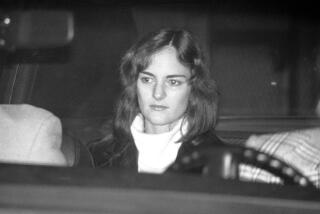Sara Olson Defense Seeks Records From Hearst Case
- Share via
Defense attorneys in the Sara Jane Olson bomb plot case asked prosecutors Friday to turn over newspaper heiress Patty Hearst’s psychiatric reports, her statements to law enforcement officials and other documents related to her Symbionese Liberation Army kidnapping and bank robbery trial two decades ago.
Olson, 52, is scheduled to go on trial in Los Angeles Superior Court on Jan. 10. She is accused of conspiring to kill police officers by planting nail-packed pipe bombs under two police cars in August 1975. The plot was allegedly intended to avenge the deaths of SLA members. Neither device exploded.
Olson spent 23 years as a fugitive, building a respectable life as a physician’s wife and mother of three who was active in social causes and local theater. She was arrested by the FBI in June, a few blocks from her home in St. Paul, Minn.
The defense motion signals what could be a fierce court battle over the evidence and witnesses in a case built largely on circumstantial evidence.
The defense maintains that Olson’s fingerprints were not found on the bombs, nor were those of any other SLA members. They say that although there is plenty of evidence that there was a bomb, there is no direct evidence tying it to their client.
Bombs, the defense papers say, “were the political language and currency of the 1960s and ‘70s in this country.” Defense attorneys Stuart Hanlon and Susan Jordan say they have determined from news reports that 60 to 100 bombings occurred in Los Angeles between 1972 and 1976, and that other political groups could be responsible for the devices Olson is accused of planting.
The defense attorneys asked Deputy Dist. Atty. Michael Latin to turn over any reports concerning other bombing attempts directed against police, saying that although they assume such attacks occurred, police did not publicly disclose them at the time.
“Because the [LAPD] apparently chose not to reveal information about attacks upon itself to the public or the press, the information and reports remain locked in their file cabinets,” the lawyers wrote.
But Lt. Sharyn Buck, a Police Department spokeswoman, said the LAPD would not have withheld such facts.
“We’ve always had a policy about providing the media with information,” she said. “I don’t know what they’re talking about.”
The attorneys also complain in their court papers that the prosecutor has deluged them with documentation--about 2,400 pages so far--which is disorganized, seems largely irrelevant, and falls far short of what the lawyers need to mount their defense. They asked Latin to narrow his focus to evidence he intends to use at trial.
Among the documents turned over so far: lengthy political statements and communiques attributed to other SLA members, FBI reports and analyses concerning 5,000 pieces of physical evidence seized during police searches of SLA hide-outs in San Francisco and Sacramento, and police reports of interviews with about 500 witnesses.
“Only a small portion of this discovery deals with the actual attempted bombing in Los Angeles,” the motion says.
“The defense can only surmise that the government’s theory is that the attempted bombing of police cars in Los Angeles was simply another part of a larger uncharged, free-flowing anti-government conspiracy. It would appear that the [prosecution] theory . . . is that Mrs. Olson was an alleged member of the SLA and therefore responsible for any criminal acts allegedly conducted by them.”
Sandi Gibbons, a spokeswoman for the district attorney’s office, said prosecutors were just doing their job.
“Our job is to give them the discovery,” she said. “Under the law we have to provide them with information, and that’s exactly what we did.”
The defense also requested a list of prosecution witnesses.
Early in the case, prosecutor Latin identified Hearst as a potential witness--and she publicly expressed reluctance about testifying. Now married and raising children in Connecticut, Hearst says she is not eager to dredge up details from her past.
Still, Olson’s defense attorneys have requested transcripts of Hearst’s trial, and of any psychiatric evaluations and reports used in the case to gauge the impact of her kidnapping on her mental state. She ultimately was convicted.
The paths of Hearst and Olson, then known as Kathleen Soliah, crossed during the 1970s, when both were associated with the radical SLA. Hearst was kidnapped by the SLA but joined her captors and was convicted of robbing a San Francisco bank; Olson was a sympathizer who allegedly became active after six SLA members were killed in a 1974, shootout with Los Angeles police.
More to Read
Sign up for Essential California
The most important California stories and recommendations in your inbox every morning.
You may occasionally receive promotional content from the Los Angeles Times.













